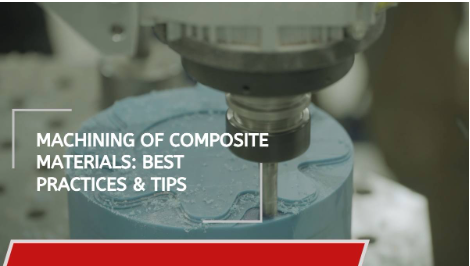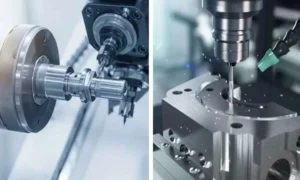Fiber Reinforced Composites are extremely challenging to process optimally. Their unique structure, together with a variety of materials, requires specialized tooling. But, the advantages should not be overshadowed by the drawbacks because the composites are poised to power future and emerging technologies. Generally, you’ll need to navigate many issues when it comes to machining composites. These include diverse properties and the accuracy that is necessary to preserve the structures intact. Composite CNC Machining is an innovative technology in today’s manufacturing.
In this blog post, we will provide the major challenges and necessary advice for the machining of composites. So you can understand the intricacies and procedures involved in machining composite materials.
What Are Composite Materials & Their 3 Main Constituents
Main Constituents of Composites
Composites are materials typically made of 2 or 3 different materials to achieve inevitable characteristics. These materials rely on three main components:
- Reinforcements
- Interface, and
- Matrix.
Matrices
These are the framework of Composites. Matrix holds reinforcement materials. Besides, these combine to give them shape and protection in severe conditions. Different matrices suit specific needs. For example:
- Polymer Matrices do not corrode over time. Also, these have low density, which makes them useful for making consumer items and custom car parts.
- Ceramic Matrices can withstand high thermal conditions, making them right for aerospace pieces.
- Metal Matrices comprise high-impact strength and durability. They are suitable for handling large loads.
Reinforcements
Reinforcements help increase the mechanical characteristics of composites alongside their density. Common reinforcements include:
- Carbon Fibers, have a high strength and stiffness for advanced applications.
- Glass Fibers, affordable and sturdy, find diverse uses.
- Staple, aramid fibers are tough and most suitable for ballistic and aerospace industries.
Interfaces:
Interfaces make sure the matrix and reinforcements are integrated properly. Additionally, it relays loads and also improves the performance of structures. Key interface types are:
- Mechanical Interlocking depends on the roughness of reinforcement in load-bearing composite materials.
- Surface Treatments to provide adhesion are made possible by chemical bonding.
- Thermal Bonding, the use of heat for bonding is frequently used in automotive thermoplastics.
Exact Steps in Composite CNC Machining
Composite CNC Boring
Here’s a breakdown of the machining composites procedure:
Selection of Material:
Select a suitable composite material depending on the requirements of a particular project. In general, machinists consider properties like strength, heat resistance, prices for the material, etc.
Design and Programming
Mechanically design the part in AutoCAD and convert their designs into CNC-compatible codes using CAM. The plan proposed should be intended for the performance of composite machining.
Machine Setup
Set the parameters of the CNC machine common to a required task. Install the appropriate tools and enter the numeric control codes.
Equipment and Tool Setting
Next, you must fix the composite material properly so that during processing no further damages occur. In addition, sharpen the cutting tools for the composite materials to avoid finesse.
Machining Process
Perform the programmed cuts, including, carving, boring, and sculpting, with keen interest since you may encounter overheating or delamination problems.
Post-Processing
Perform finishing tasks like trimming, sanding, or polishing to meet the desired dimensions and surface quality.
Inspection and quality assurance
Next, conduct a visual check to confirm all the parts meet the required tolerances, dimensions, and other qualities in the finished part.
Types of Composite Materials Used in CNC Machining
Below is a comprehensive list of composite materials commonly used in CNC machining applications.
- Carbon Fiber Reinforced Polymer (CFRP)
- Natural Fiber Reinforced Polymer (NFRP)
- Hybrid Composites
- g10 fr4 (read more about g10 fr4 material properties & g10 fr4 machining)
- Boron Fiber Reinforced Polymer (BFRP)
- Silicon Carbide Reinforced Polymer (SiCRP)
- Glass Fiber Reinforced Polymer (GFRP)
- Aramid Fiber Reinforced Polymer (AFRP)
- Basalt Fiber Reinforced Polymer (BFRP)
- Metal Matrix Composites (MMC)
- Ceramic Matrix Composites (CMC)
- Polymer Matrix Composites (PMC)
Common Techniques Used for Composite CNC Machining?
Here are techniques involved in machining of composite materials:
Composite CNC Milling
Composite CNC Milling
In milling, rotary cutting tools are used to cut the material from the composite workpiece. It is suited to generate intricate contour features in parts.
Composite CNC Drilling
Composite CNC Drilling
CNC drills can make accurate contours in the mass-scale production of composite materials. These holes are produced and tested for accuracy.
Composite CNC Turning
CNC Turned Composite Parts
CNC turning has a single cutting point. In operation, the workpiece revolves while it translates. Turning is the right fit for cutting composite cylindrical workpieces of any cross-sectional symmetry.
Composite CNC Routing
Composite Routing
Routing cutting tools create evident designs like curved and or rounded shapes in composite materials without causing too much damage.
Composite Waterjet Cutting
Waterjet cutting composite
Waterjet cutting uses high-pressure water without abrasives to effectively cut the composites without having to induce heat.
Composite Laser Cutting
Composite Laser Cutting
A high-powered laser machine cuts composites perfectly for thin pieces of material but may impart heat damage during operation.
Grinding
Fine Rib Rubber Sheets
Grinding imparts composite surfaces to produce a high-quality, smooth finish and deteriorates the integrity of the material by generating heat.
Composite Machining Tips: What to Know and Watch For
Let’s talk about optimization tips for machining of composite materials:
Cost Efficiency Matters
Composite materials are usually expensive. Because they involve several production methodologies to achieve combined features, besides, these materials should not be wasted through improper usage. Therefore, machinists must employ the right tools suitable for composites.
Consider Material Volatility
Generally, composites are mechanically complicated to machines because of their heterogeneous nature. In some cases, after machining you may find some dimensions might not be smaller than desired. To prevent this, knowledge of the various types of materials and their behavior in operation is vital so that deviations can be minimized.
Managing Heat Dissipation
Machining of composite materials tends to generate high heat since the material has low thermal conductivity. This heat can bring side effects such as warping or even outright melting of some of the materials. Here, applying coolants and optimum tools in composite fabrication can assist in controlling the temperature, obtaining high accuracy, and working throughout the process.
Meeting Health and Safety Issues
Composites like carbon fiber upon machining normally generate dust. If it is inhaled causes respiratory issues in humans. To protect yourself from infections, always wear protective clothing like a mask or face shield. Moreover, proper collection and exhaust are also keen to keep the workplace safe in the long run.
Industries Using Composites For Machining Products
- Aerospace
- Automotive
- Defence (Military)
- Marine
- Transport
- Renewable Energy
Summary
Machining of Composite Materials remains a significant challenge because these materials are heterogeneous. Unlike regular types of metals, there are differences in the carbon fiber, fiber type, the weave pattern, and the type of the matrix. Consequently, there are various issues encountered that engineers must address including issues like delamination, tool wear, and heat generation. In such cases, thread milling is suitable to opt for rather than tapping for threading of composites because it has lower cutting forces and is also safe from tool breakage.
FAQ
Q1. Why is thread milling chosen over tapping in composites?
Thread Milling is a preferred technique for generating threads in composites. The milling composite materials exert less cutting force, produce short chips, and cut down the undue load on the cutting tool.
Q2. How does tool wear impact composite machining?
Wear and tear of the tools increase feed rates and produce delamination as well as inferior surface finishes.
Q3. How can delamination during composite machining be minimized?
To minimize delamination, the correct feed rate, sharp cutting tools, and cutting data should be incorporated. Additionally, you must prevent high thrust forces which can cause the layers’ bonds to be ruptured.
Q4. Why is carbide better for composites?
Carbide tools have higher resistance to wear and tear, last longer, and comprise the required strength to cut through tough composite materials such as glass fibers.
Q5. What factors should be taken into consideration when selecting the tools for composite material machining?
The factors include tool life, cutting data, heat dissipation, and vibration. The right tool should be chosen according to the material and the application so that the desired characteristics and part finish are obtained.
Q6. Is it possible to use coolant when machining composites?
Coolant is not a good idea; it may have an impact on such composites’ material characteristics. However, tools are typically designed for composite machining where coolant can be incorporated to control the unnecessary heat build-up.



































